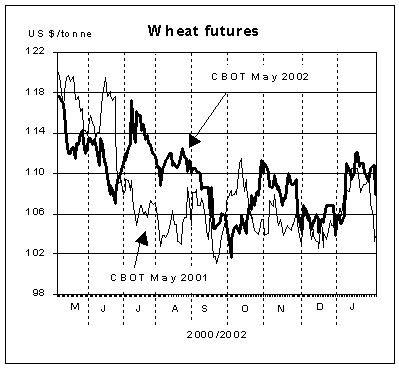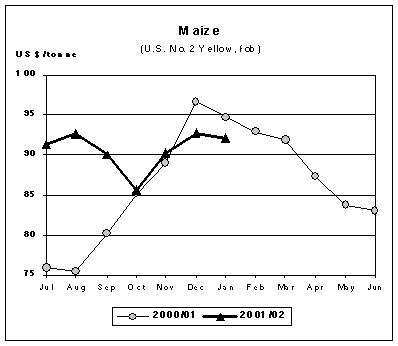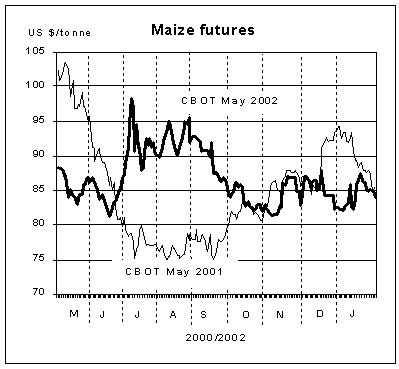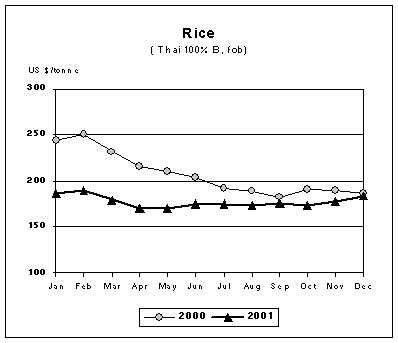|
2002
|
2001
|
||
|
Jan.
|
Nov.
|
Jan.
|
|
|
(. . . . . . US$/tonne . . . . . .)
|
|||
|
United States
|
|
|
|
|
Wheat
|
128
|
128
|
134
|
|
Maize
|
92
|
90
|
95
|
|
Sorghum
|
97
|
96
|
104
|
|
Argentina
|
|
|
|
|
Wheat
|
115
|
109
|
122
|
|
Maize
|
89
|
93
|
91
|
|
Thailand
|
|
|
|
|
Rice white
|
197
|
178
|
187
|
|
Rice, broken
|
145
|
135
|
134
|
International wheat prices remain mostly below the previous season despite a stagnation in global wheat production and, even more importantly, a sharp drop in output among the major wheat exporting countries. The rise in world wheat imports has so far failed to provide the necessary support for any sustained increase in prices, although prices for high quality milling wheat have remained firmer because of tighter global supplies and stronger demand. On the whole, the unusual low wheat exports from the EC and uncertainties surrounding the situation in Argentina should have provided the stimulus for stronger prices, but excess supplies in the CEECs, as well as India and Pakistan, have stabilized world prices. In January, the US wheat No. 2 (HRW, fob) averaged US$128 per tonne, unchanged from November 2001, and US$6 per tonnes below the corresponding period last year. The remainder of the season might see a gradual bottoming of prices, although the overall picture remains uncertain and much will depend on 2002 production prospects in the Northern Hemisphere. Recent movements in the US wheat futures at the Chicago Board of Trade (CBOT) have displayed a more volatile but indecisive pattern. Overall, wheat futures remain close to the levels registered in the corresponding period last year but, by late January, the CBOT May futures were quoted at US$108 per tonne, down slightly from the beginning of the month.


International maize price movements also tended to display a similar pattern as wheat, given their very comparable supply/demand conditions. The rise in world maize production and the exceptionally large export supplies from a number of non-traditional exporters, such as Brazil, continue to weigh on the market. In January, the US maize export price quotations for US No.2 Yellow averaged US$92 per tonne, up US$2 from November 2001 but still below the corresponding period last year. In light of the subdued world demand, the prospect for any moderate increase in prices over the next few months also remains limited. In recent weeks, the CBOT values have fallen below the levels of the previous season and, by late January, the May maize futures were quoted at US$84 per tonne, still lower than last year.


International rice prices have shown signs of a recovery since the last report in December, with the FAO price index averaging 90 in January, 2 points above November. However, prices for individual types have followed divergent trends. Rices from Thailand have benefited from strong import demand, in part because of the temporary withdrawal from the market of Viet Nam, and from the launching of a new round of Government domestic purchases in November. The price of the higher quality Thai 100% B reached US$197 per tonne in January, up from US$178 per tonne in November (see Graph). Prices for the lower quality Thai A1 Super also firmed from the November level, but strong competition from India depressed prices of parboiled rice.

Large domestic supplies from the excellent 2001 crop continued to exert strong downward pressure on rice quotations in the United States. As a result, most prices of rices from the United States fell between November and January, including the price of the higher quality, long grain rice N. 2/4, which dipped from US$214 per tonne to US$208 per tonne.
The divergence of trends in Thailand and the United States has significantly narrowed the price differential traditionally existing between similar rices from the two origins. For instance, the United States price premium on the high quality long grain was only US$11 per tonne in January, down from US$52 per tonne in November and US$104 per tonne in January last year.
Among the other traditional exporters, prices of Indian parboiled rice remained particularly competitive at US$155 per tonne in January. By contrast, low supplies in Viet Nam and Pakistan and the ending of the subsidy programme last September in Egypt have pushed prices up further since November in the three countries.
Prospects for prices in the next few months remain uncertain, although the global supply/demand situation continues to be tight. Indeed, the maintenance of subsidized export prices in India could weigh heavily on the market until the end of March, and beyond, if the programme is extended. By March, Viet Nam is likely to return on the market with fresh rice supplies for export. The prospects for prices in the next few months will then very much depend on the size of the new rice crops coming onto the market (the secondary 2001 crops on the northern hemisphere and the main 2002 crops on the southern hemisphere) and on whether China will start buying.